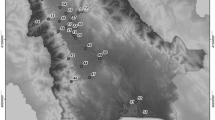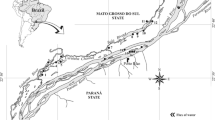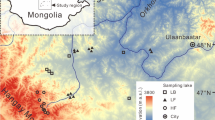Abstract
Eight glacial lakes of the Bohemian Forest (Czech Republic and Germany) were characterised by the distribution of chironomids collected as pupal exuviae. Twenty-eight taxa were identified, including some faunistically interesting species of the region. Two-way indicator species analysis (TWINSPAN) was used to classify lakes according to their taxonomic composition. Canonical correspondence analysis (CCA) and multiple regression were used to relate the chironomid assemblages to two sets of explanatory variables: (i) local environmental variables, and (ii) broad-scale spatial variables. The TWINSPAN classified the lakes into four groups, whereas presence/absence of three taxa was indicative for this classification. The CCA of assemblage composition on environmental variables showed that chironomids respond significantly to altitude and alkalinity. The ordination of composition data on geographical variables revealed strong longitudinal gradient in chironomid distributions. Altitude and alkalinity accounted for 36.2% of the total variation, while the geographic gradient explained 20.5%. As revealed by the variation partitioning procedure, the significant effect of these variables was, in large part, independent of each other. Overall taxonomic richness appeared to be governed by altitude only. Causal ecological and historical factors underlying these results are discussed. This paper may provide a basis for hypothesis testing in future research of the Bohemian Forest lakes.
Similar content being viewed by others
References
Armitage, P.D. 1995. Behaviour and ecology of adults, pp. 194–224. In: Armitage, P.D., Cranston, P.S. & Pinder, L.C.V. (eds) The Chironomidae: Biology and ecology of nonbiting midges, Chapman & Hall, London.
Belbin, L. & McDonald, C. 1993. Comparing three classification strategies for use in ecology. J. Veg. Sci. 4: 341–348.
Bitušík, P. 2006. Faunistic records: Chironomidae. Dipterologica Bohemoslovaca 13, Acta Univ. Carol., Biol. (in press).
Bitušík, P. & Kubovčík, V. 2000. Sub-fossil chironomid assemblages (Diptera: Chironomidae) from the Černé lake and Prášilské lake (Bohemian Forest, Czech Republic). Silva Gabreta 4: 253–258.
Bitušík, P., Svitok, M., Kološta, P. & Hubková, M. 2006. Classification of the Tatra Mountains lakes (Slovakia) using chironomids (Diptera, Chironomidae). Biologia, Bratislava 61,Suppl. 18: S191–S201.
Block, W., Burn, A.J. & Richard, K.J. 1984. An insect introduction to the maritime Antarctic. Biol. J. Linn. Soc. 23: 33–39.
Borcard, D. & Legendre, P. 1994. Environmental control and spatial structure in ecological communities: an example using oribatid mites (Acari, Oribatei). Environ. Ecol. Stat. 1: 37–61.
Borcard, D. & Legendre, P. 2002. All-scale spatial analysis of ecological data by means of principal coordinates of neighbour matrices. Ecol. Model. 153: 51–68.
Borcard, D.P., Legendre, P. & Drapeau, P. 1992. Partialling out the spatial component of ecological variation. Ecology 73: 1045–1055.
Bowerman, B.L. & O’Connell, R. 1990. Linear statistical models: An applied approach, 2nd edition, Duxbury Press, Belmont, California, 1040 pp.
Brodersen, K.P. & Lindegaard, C. 1999. Classification, assessment and trophic reconstruction of Danish lakes using chironomids. Freshwater Biol. 42: 143–157.
Brodersen, K.P., Pedersen, O., Lindegaard, C. & Hamburger, K. 2004. Chironomids (Diptera) and oxy-regulatory capacity: An experimental approach to paleolimnological interpretation. Limnol. Oceanogr. 49: 1549–1559.
Brodin, Y.-W. 1990. Midge fauna development in acidified lakes in northern Europe. Philos. Trans. R. Soc. Lond. B. Biol. Sci. 327: 295–298.
Brown, A.E. & Oldham, R.S. 1984. Chironomidae (Diptera) of Rutland Water. Arch. Hydrobiol. Suppl. 69: 199–227.
Delettre, Y.R. & Morvan, N. 2000. Dispersal of adult aquatic Chironomidae (Diptera) in agricultural landscapes. Freshwater Biol. 44: 399–411.
Dowling, C. & Murray, D.A. 1981. The distribution of the Chironomidae (Diptera) in two Irish blanket bogs. Proc. R. Irish Acad. 81: 53–61.
Ekrem, T. 2004. Immature stages of Europaean Tanytarsus species I. The eminulus-, gregarius-, lugens- and mendax species groups (Diptera, Chironomidae). Mitt. Mus. Natkd. Berl., Dtsch. Entomol. Z. 51: 97–146.
Fittkau, E.J. 1962. Die Tanypodinae (Diptera, Chironomidae). Abh. Larvalsyst. Insekten 6: 1–453.
Fott, J., Pražáková, M., Stuchlík, E. & Stuchlíková, Z. 1994. Acidification of lakes in Šumava (Bohemia) and in the High Tatra Mountains (Slovakia). Hydrobiologia 274: 37–47.
Gotelli, N.J. & Entsminger, G.L. 2006. EcoSim: Null models software for ecology. Version 7. Acquired Intelligence Inc. & Kesey — Bear. Jericho, VT 05465. http://garyentsminger.com/ecosim.htm. 21.06.2006.
Green, A.J. & Sánchez, M.I. 2006. Passive internal dispersal of insect larvae by migratory birds. Biology Letters 2: 55–57.
Heinis, F. & Davids, C. 1993. Factors governing the spatial and temporal distribution of chironomid larvae in the Maarseveen Lakes with special emphasis on the role of oxygen conditions. Neth. J. Aquat. Ecol. 27: 21–34.
Hill, M.O. 1979. TWINSPAN — a FORTRAN program for arranging multivariate data in an ordered two-way table by classification of the individuals and attributes. Cornell University, Ithaca, New York.
Hill, M.O. & Šmilauer, P. 2005. TWINSPAN for Windows version 2.3. Centre for Ecology and Hydrology & University of South Bohemia, Huntingdon & České Budejovice, 29 pp.
Hoffrichter, O. 1973. On the role of traffic as possible means of dispersal in chironomids. Chironomus 1: 102–104.
Hurlbert, S.H. 1971. The nonconcept of species diversity: a critique and alternative parameters. Ecology 52: 577–586.
King, R.S., Baker, M.E., Whigham, D.F., Weller, D.E., Jordan, T.E., Kazyak, P.F. & Hurd, M.K. 2005. Spatial considerations for linking watershed land cover to ecological indicators in streams. Ecol. Appl. 15: 137–153.
Kopáček, J., Stuchlík, E., Veselý, J., Schaumburg, J., Anderson, I.C., Fott, J., Hejzlar, J. & Vrba, J. 2002. Hysteresis in reversal of Central European mountain lakes from atmospheric acidification. Water Air Soil Pollut.: Focus 2: 91–114.
Kopáček, J., Turek, J., Hejzlar, J., Kaňa, J. & Porcal, P. 2006. Element fluxes in watershed-lake ecosystems recovering from acidification: Plešné Lake, the Bohemian Forest, 2001–2005. Biologia, Bratislava 61,Suppl. 20: S427–S440.
Kopáček, J., Veselý, J., & Stuchlík, E. 2001. Sulphur and nitrogen fluxes and budgets in the Bohemian Forest and Tatra Mountains during the industrial revolution (1850–2000). Hydrol. Earth Syst. Sci. 5: 391–405.
Krno, I., Šporka, F., Galas, J., Hamerlík, L., Zaťovičová, Z. & Bitušík, P. 2006. Litttoral benthic macroinvertebrates of mountain lakes in the Tatra Mountains (Slovakia, Poland). Biologia, Bratislava 61,Suppl. 18: S147–S166.
Langton, P.H. 1991. A key to pupal exuviae of West Palaearctic Chironomidae. Privately published by P.H. Langton, 3 St. Felix Road, Ramsay Forty Foot, Cambridgeshire, England, PE 17 1YH, 386 pp.
Langton, P.H. & Visser, H. 2003. Chironomidae exuviae. A key to pupal exuviae of the West Palaearctic Region. Interactive Identification System for the Europaean Limnofauna (IISEL), World Biodiversity Database, CD-ROM Series.
Larocque, I., Hall, R.I. & Grahn, E. 2001. Chironomids as indicators of climate change: a 100-lake training set from a subarctic region of northern Sweden (Lapland). J. Paleolimnol. 26: 307–322.
Legendre, P. 1990. Quantitative methods and biogeographic analysis, pp. 9–34. In: Garbary, D.J. & South, R.R. (eds) Evolutionary biogeography of the marine algae of the North Atlantic, NATO ASI Series vol. G 22, Springer-Verlag, Berlin, Germany.
Legendre, P. 1993. Spatial autocorrelation: trouble or new paradigm? Ecology 74: 1659–1673.
Legendre, P., Dale, M.R.T., Fortin, M.-J., Gurevitch, J., Hohn, M. & Myers, D. 2002. The consequences of spatial structure for the design and analysis of ecological field surveys. Ecography 25: 601–615.
Legendre, P. & Legendre, L. 1998. Numerical ecology, 2nd edition. Developments in Environmental Modelling 20. Elsevier Science B.V., Amsterdam, 853 pp.
Lichstein, J.W., Simons, T.R., Shriner, S.A. & Franzreb, K.E. 2002. Spatial autocorrelation and autoregressive models in ecology. Ecol. Monogr. 72: 445–463.
Liebhold, A.M. & Gurevich, J. 2002. Integrating statistical analysis of spatial data in ecology. Ecography 25: 553–557.
Lindegaard, C. 1995. Classification of water-bodies and pollution, pp. 385–404. In: Armitage, P.D., Cranston, P.S. & Pinder, L.C.V. (eds) The Chironomidae: Biology and ecology of non-biting midges, Chapman & Hall, London.
Lotter, A.F., Birks, H.J.B., Hofmann, W. & Marchetto, A. 1997. Modern diatom, cladocera, chironomid, and chrysophyte cyst assemblages as quantitative indicators for the reconstruction of past environmental conditions in the Alps. I. Climate. J. Paleolimnol. 18: 395–420.
Meriläinen, J.J. & Hynynen, J. 1990. Benthic invertebrates in relation to acidity in Finnish forest lakes, pp. 1029–1049. In: Kauppi, P., Anttila, P. & Kenttämies, K. (eds) Acidification in Finland, Springer-Verlag, Berlin, Heidelberg.
Nedbalová, L., Fott, J., Kohout, L., Kopáček, J., Macek, M., Soldán, T. & Vrba, J. 2006. Biological recovery of the Bohemian Forest lakes from acidification. Biologia, Bratislava 61,Suppl. 20: S453–S465.
Nyman, M.T. & Korhola, A.A. 2005. Chironomid-based classification of lakes in western Finnish Lapland. Boreal Environ. Res. 10: 239–254.
Oksanen, J. & Minchin, P.R. 1997. Instability of ordination results under changes in input data order: explanations and remedies. J. Veg. Sci. 8: 447–454.
Olander, H., Korhola, A. & Blom, T. 1997. Surface sediment Chironomidae (Insecta: Diptera) distributions along a ecotonal transect in subarctic Fennoscandia: developing a tool for paleotemperature reconstructions. J. Paleolimnol. 18: 211–230.
Papáček, M. & Soldán, T. 1995. Biogeograficky významné druhy vodního hmyzu (Ephemeroptera, Odonata, Plecoptera, Heteroptera: Nepomorpha) v oblasti Šumavy. Klapalekiana 31: 41–51.
Quinn, G.P. & Keough, M.J. 2002. Experimental design and data analysis for biologists. Cambridge University Press, Cambridge, UK, 520 pp.
Ruse, L. 2002a. Chironomid pupal exuviae as indicators of lake status. Arch. Hydrobiol. 153: 367–390.
Ruse, L. 2002b. Colonisation of gravel lakes by Chironomidae. Arch. Hydrobiol. 153: 391–407.
Sæther, O.A. 1979. Chironomid communities as water quality indicators. Holarct. Ecol. 2: 65–74.
Schnell, O.A. & Willassen, E. 1996. The chironomid (Diptera) communities in two sediment cores from Store Hovvatn, S. Norway, an acidified lake. Ann. Limnol. 32: 45–61.
Seminara, M., Bazzanti, M. & Tamorri, C. 1990. Sublittoral and profundal chironomid (Diptera) communities of Lake Vico (Central Italy): relationship to the trophic level. Ann. Limnol. 26: 183–193.
Simberloff, D. 1978. Use of rarefaction and related methods in ecology, pp. 150–165. In: Dickson, K.L., Cairns, J. jr, & Livingston, R.J. (eds) Biological data in water pollution assessment: quantitative and statistical analysis, ASTM STP 652, American Society for Testing and Materials, Philadelphia, Pennsylvania.
Soldán, T., Landa, V. & Zahrádková, S. 1999. Long-term changes of diversity of mayflies (Ephemeroptera) in the Křemelná river basin (Šumava Mts, Czech Republic). Silva Gabreta 3: 95–114.
Soldán, T., Papáček, M., Novák, K. & Zelený, J. 1996. The Šumava Mountains: a unique biocentre of aquatic insects (Ephemeroptera, Odonata, Plecoptera, Megaloptera and Heteroptera — Nepomorpha). Silva Gabreta 1: 179–186.
Soldán, T., Zahrádková, S., Helešic, J., Dušek, V. & Landa, V. 1998. Distributional and quantitative patterns of Ephemeroptera and Plecoptera in the Czech Republic: a possibility of detection of long-term environmental changes of aquatic biotopes. Folia Fac. Sci. Nat. Univ. Masaryk. Brun., Biol. 98: 1–306.
StatSoft, Inc. 2001. STATISTICA (data analysis software system), Version 6.
ter Braak, C.J.F. 1986. Canonical correspondence analysis: a new eigenvector technique for multivariate direct gradient analysis. Ecology 67: 1167–1179.
ter Braak, C.J.F. 1995. Ordination, pp. 91–173. In: Jongman, R.H.G., ter Braak, C.J.F. & van Tongeren, O.E.R. (eds) Data analysis in community and landscape ecology, Cambridge University Press, Cambridge, UK.
ter Braak, C.J.F. & Šmilauer, P. 2002. CANOCO reference manual and CanoDraw for Windows user’s guide: software for canonical community ordination (Version 4.5). Microcomputer Power, Ithaca, New York, USA, 500 pp.
Veselý, J. 1994. Investigation of the nature of the Šumava lakes: a review. Čas. Nár. Mus. Praha, Řada Přírodověd. 163: 103–120.
Vrba, J., Fott, J. & Kopáček, J. 2000. Long-term limnological research of the Bohemian Forest lakes and their recent status. Silva Gabreta 4: 7–28.
Vrba, J., Kopáček, J., Fott, J., Kohout, L., Nedbalová, L., Pražáková, M., Soldán, T. & Schaumburg, J. 2003. Long-term studies (1871–2000) on acidification and recovery of lakes in the Bohemian Forest (central Europe). Sci. Total Environ. 310: 73–85.
Walker, I.R., Smol, J.P., Engstrom, D.R. & Birks, H.J.B. 1991. An assessment of Chironomidae as quantitative indicators of past climatic change. Can. J. Fish. Aquat. Sci. 48: 975–987.
Wiederholm, T. (ed.) 1983. Chironomidae of the Holarctic region. Part 1. Larvae. Entomol. Scand., Suppl. 19: 1–457.
Wiederholm, T. (ed.) 1986. Chironomidae of the Holarctic region. Part 1. Pupae. Entomol. Scand., Suppl. 28: 1–482.
Wiederholm, T. & Eriksson, L. 1977. Benthos of an acid lake. Oikos 29: 261–267.
Wilson, R.S. & Bright, P.L. 1973. The use of chironomid pupal exuviae for characterizing streams. Freshwater Biol. 3: 283–302.
Wilson, R.S. & Ruse, L.P. 2005. A guide to the identification of genera of chironomid pupal exuviae and their use in monitoring lotic and lentic fresh waters. Freshwater Biol. Assoc., 164 pp.
Yamasaki, S.H., Pelletier, B., Dutilleul, P. & Fyles, J.W. 1999. Sign, magnitude, and elements of ecological interpretation of shared variation among predictor variables in multiple regression: I. The univariate case, pp. 147–162. In: Yamasaki, S.H. (ed.) Influences of Kalmia angustifolia on black spruce in eastern Canada’s boreal forest, National Library of Canada, Ottawa, Canada.
Author information
Authors and Affiliations
Rights and permissions
About this article
Cite this article
Bitušík, P., Svitok, M. Structure of chironomid assemblages along environmental and geographical gradients in the Bohemian Forest lakes (Central Europe): An exploratory analysis. Biologia 61 (Suppl 20), S467–S476 (2006). https://doi.org/10.2478/s11756-007-0063-y
Received:
Accepted:
Issue Date:
DOI: https://doi.org/10.2478/s11756-007-0063-y




